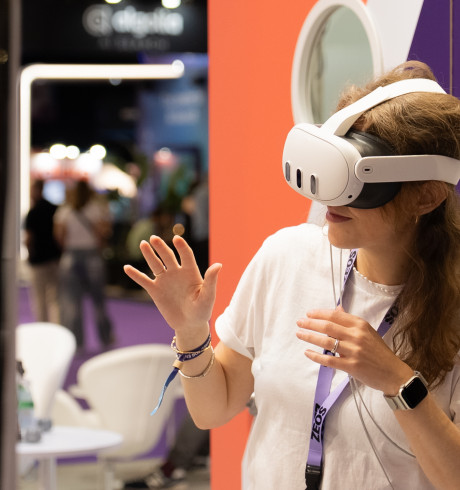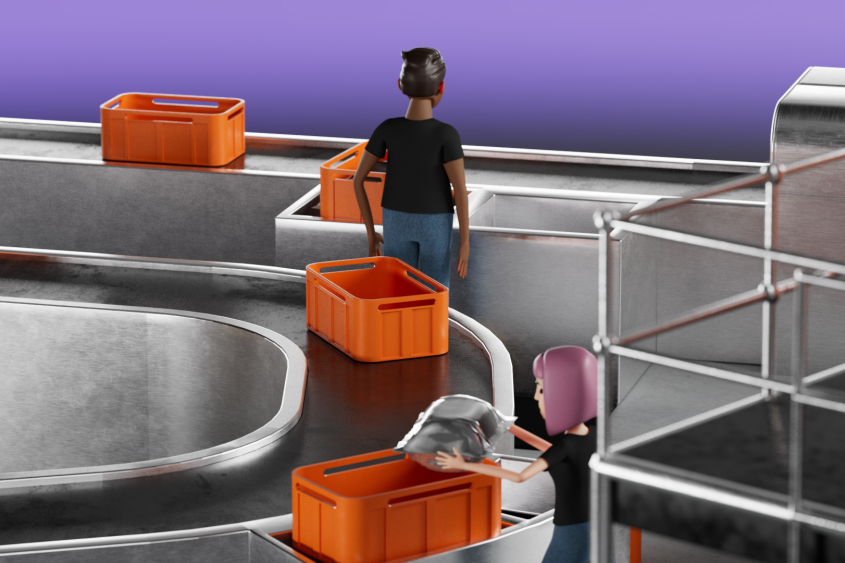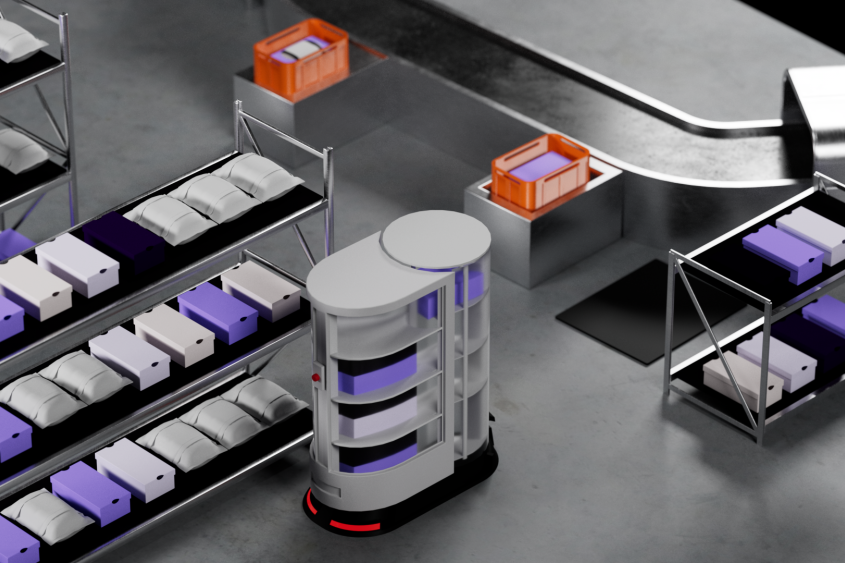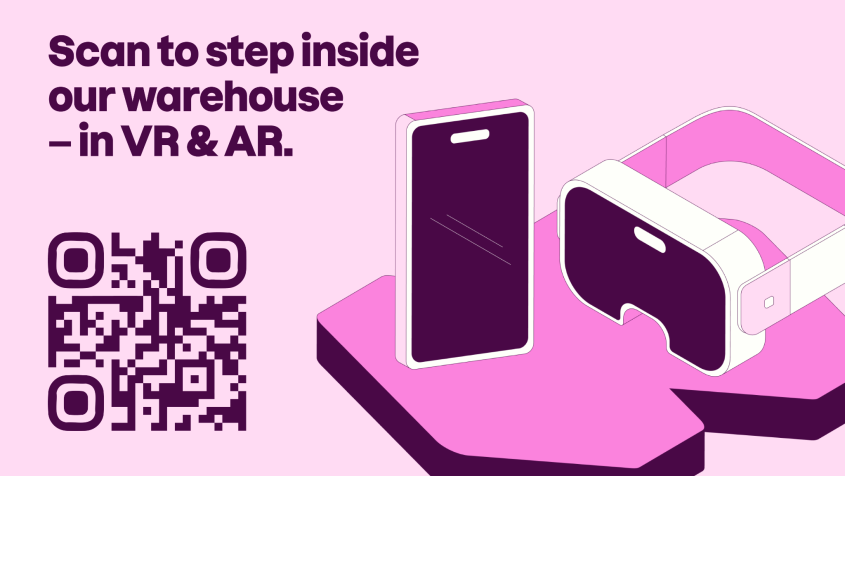Curious what happens after checkout? Explore the Zalando logistics journey in AR
Curious what happens after checkout? Explore the Zalando logistics journey in AR

An inside look into the Zalando fulfilment process
What does it actually look like inside a Zalando warehouse? From the moment products arrive at our logistics centre, they go through a seamless process. Together with ZEOS, we launched an AR experience app that brings each stage of this journey to life: from unloading deliveries to prepping returns. Here's a quick walk-through of the full immersion you'll explore in the virtual tour.
Receive: The starting point of our journey
Our logistics process begins in the receive area, where deliveries from all over the world arrive every day with items like shoes, clothing, and beauty products. To ensure a smooth and safe workflow, we use modern equipment, such as forklifts for unloading goods efficiently. Load by load, the goods are carefully inspected: Are all items accounted for? Are they in perfect condition? Is the number of individual packages accurately documented?
Our receiving team then assigns a unique barcode, called the quality label to every product. This allows us to track and locate items quickly in our warehouse and across our logistics network. This process takes place at automated and ergonomic workstations, ensuring efficiency and employee well-being. Sustainability is important to us: all empty cardboard boxes are recycled to ensure a more circular operation.

Stow: Storing items efficiently
The pick tower is the heart of the fulfilment centre; this is where we store millions of exciting products before shipping them to customers. Two key processes take place here: stowing (placing items received onto shelves) and picking (retrieving products for customer orders). T-shirts, jackets, and shoes are stored side by side in what, at a distance, may appear to be ‘organised chaos.’
Managing millions of products isn’t easy – but we’ve got smart systems in place to handle it. So, what does that actually mean? During the stowing process, employees don’t need to search for specific storage locations. Instead, a handheld scanner guides them to the next available spot on the shelves or other locations. Our innovative software system, ZalOS, developed by Zalando, powers the scanners and all other logistics processes in our network. This flexible and dynamic storage system makes the picking process much more efficient; employees can collect items sequentially along a recommended route and avoid unnecessary detours.
Pick: Collecting items from the warehouse
The pick process takes place in the pick tower, where items are collected from the shelves for customer orders. Once an item has been stowed, it waits to be picked for an order. As soon as a customer places an order, an employee receives the details on a handheld scanner and retrieves the item. AI plays a key role in our logistics: It helps reduce processing times and calculates the most efficient delivery routes. Our custom warehouse management system, ZalOS, ensures smooth order processing.
At Zalando, we are continuously investing in automation. This has two main benefits: Firstly, it supports employees. Automating tasks that are repetitive or physically demanding allows our teams to focus on more complex processes instead. Secondly, faster and smarter logistics mean quicker deliveries and a seamless shopping experience for our customers. A great example is our TORU mobile robot, designed to assist with unergonomic tasks, such as picking shoe boxes. TORU operates in our picking shelves and can move up to 35,000 shoe boxes per day.

Sort: Getting orders ready for packing
Once the items are collected in the pick tower, the next step is to sort them into individual customer orders. We use several types of sorting machines. One of them is the bag sorter—an advanced system where each item is placed into its own dedicated bag. From there, items are temporarily stored, sorted, and automatically transported to packing stations.
Originally designed purely for sorting, at Zalando we’ve adapted this system to also function as storage for what's known as ‘fast-moving’ items – products that sell quickly and in large volumes due to high customer demand. The bag sorter has an impressive storage capacity of around 700,000 bags and works seamlessly with the conveyor system.
Pack: Sending orders on their way
Packaging plays a crucial role in our commitment to sustainability and reducing our environmental footprint. Since we offer a huge variety of products, we need flexible packaging solutions. To tackle this, we use machine learning to analyse data and optimise how we package each item. Our rule of thumb: bag before box. This improves product-to-packaging ratios, and allows us to fit more shipments into a truck.
Once orders are packed, they move to the shipping department, the final stage in the process. Here, we use chutes that look like slides. Each chute is assigned to a specific country or domestic destination. After sorting, parcels are loaded onto trailers from our shipping partners and are then ready to be delivered to their final destinations. We want to provide a quality and delightful experience for our customers. Working with more than 40 logistics providers around Europe helps us ensure that orders reach customers conveniently no matter where they are or what they order.
Returns: How items come back to us
Returns have been an integral part of our service promise since day one. We aim to provide customers with a great shopping experience by bringing the fitting room into their homes. Customers can order several items, try them on, and keep and pay only for what they love and what fits. But what happens when an item is returned? Across Europe, in our special return centres and within our main logistics centres, we handle each returned item with care. First, workers scan each item to verify that it matches the original order. This ensures we receive the item the customer wants to return, not something else by mistake. If there is a problem, we reach out to customer service for help.
Next, we check the condition of each item. If it's in perfect shape, it moves straight to the centre’s outbound area, ready for its next journey to a customer or partner. But sometimes, items need a little extra care – maybe a stain, a loose thread, or just a bit of cleaning after being tried on. These pieces are sent to refurbishment, where tailors, shoemakers, and cleaning specialists work their magic to fix minor flaws. For example, there's a spot-cleaning area with high-pressure tools to remove stains from shoes, and a sewing station stocked with threads in many colours to repair loose seams.
Finally, we decide which logistics site each item should be sent to based on factors like where it's most likely to be purchased again. From start to finish, we're making sure returns are handled efficiently with the goal of giving them a second chance, ready for a new customer.
Looking to find out more? Dive into the tour…
Zalando SE Boiler Plate EN
About Zalando
Founded in Berlin in 2008, Zalando is Europe’s leading online multi-brand fashion destination. We are building a pan-European ecosystem for fashion and lifestyle e-commerce, along two growth vectors: Business-to-Consumer (B2C) and Business-to-Business (B2B). In B2C, our two brands Zalando and ABOUT YOU, provide an inspiring, high-quality multi-brand shopping experience for fashion and lifestyle products, reaching more than 61 million active customers across 29 markets. In B2B, we offer a unique e-commerce operating system with ZEOS, Tradebyte and SCAYLE, leveraging our logistics infrastructure, software, and service capabilities to support brands and retailers in managing and scaling their entire e-commerce business across Europe.
For further information, please visit: corporate.zalando.com/en
Contact Corporate Communications
Corporate Communications
press@zalando.com
